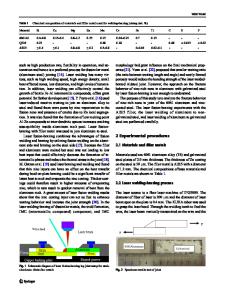Effect of adhesive on laser-arc hybrid welding of aluminum alloy to high-strength steel joint
- PDF / 1,766,265 Bytes
- 9 Pages / 595.276 x 790.866 pts Page_size
- 73 Downloads / 459 Views
ORIGINAL PAPER
Effect of adhesive on laser‑arc hybrid welding of aluminum alloy to high‑strength steel joint Hong‑yang Wang1 · Yu‑qing Ma1 · Li‑ming Liu1 Received: 31 August 2019 / Revised: 16 December 2019 / Accepted: 27 December 2019 © China Iron and Steel Research Institute Group 2020
Abstract Aluminum alloy 6061 and high-strength steel Q460 were joined by laser-arc-adhesive hybrid welding technology successfully. A Cu alloy interlayer was added between Al alloy and high-strength steel. The effect of the adhesive on laser-arc-adhesive hybrid welding of Al alloy to high-strength steel was discussed. The optical microscope, scanning electron microscope and electron probe micro-analysis were applied to observe the microstructural evolution and phase transition at Al–Fe interface of laser-arc-adhesive hybrid welded joints. The results showed the maximum tensile shear strength of the joint without adhesive was 256 MPa. After adding adhesive, the maximum tensile shear strength reached 282 MPa. The combination of the mechanical bonding and the metallurgical effect could improve the mechanical performances. The shape of the joint in Al alloy changed into a canine-like morphology. There was no porosity in welds because the molten pool of Al alloy and the special keyhole phenomenon of laser welding provided a channel for the decomposed gas to escape from fusion zone. Keywords Laser-arc welding · Aluminum alloy · High-strength steel · Cu interlayer · Adhesive
1 Introduction New anti-pollution and energy-saving laws force the vehicles industry to reduce fuel consumption. One most direct and effective way to improve fuel efficiency and reduce greenhouse gas emissions is reducing the weight of vehicles [1, 2]. In order to balance the objective of improving both fuel economy and crash safety, the joint of high-strength steel and light metal is bound to be adopted [3]. High-strength steel and Al alloy as two kinds of lightweight materials are widely used in building structure, rail transportation, aerospace and automobile industries. The composite structure of these two materials will give full play to excellent mechanical properties of high-strength steel and the lightweight effect of Al alloy, which is of great significance for promoting the energy saving and emission reduction of vehicles [4–6]. Welding is an important method to realize joining of Al alloy and steel. Numerous scholars have done a lot of studies * Li‑ming Liu [email protected] 1
Key Laboratory of Liaoning Advanced Welding and Joining Technology, School of Materials Science and Engineering, Dalian University of Technology, Dalian 116024, Liaoning, China
on Al alloy and steel welding technology, such as explosion welding [7], friction stir welding [8], resistance spot welding [9], laser welding [10], etc. Nevertheless, due to the great differences between Al alloy and steel in thermophysical properties, Al alloy/steel welding is prone to generate Fe–Al intermetallic compounds (IMC), thermal cracks and hardening welding problems [11, 12]. The addition o
Data Loading...











